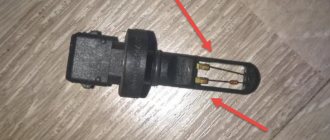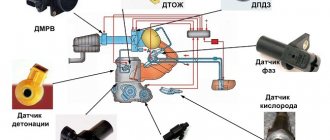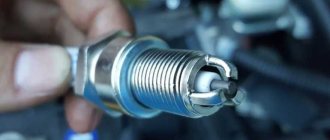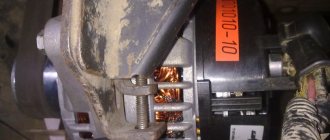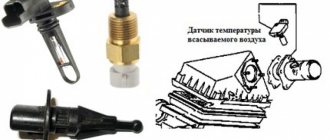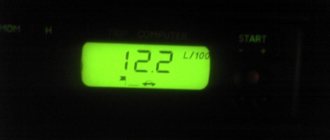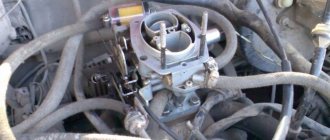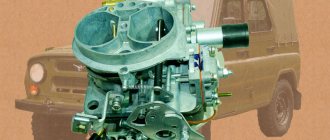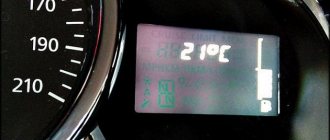DMVR diagnostic process
Air is directly related to the formation of the air-fuel mixture, and accordingly to fuel consumption. When this indicator changes, fuel consumption also changes.
Norms
So, let’s consider what is considered the standard air consumption: the Samara-2 engine, the volume of which is one and a half liters with a normally operating mass air flow sensor at 800-1000 rpm, should consume from 10±0.5 kg of air per hour of operation, and at - 2000 rpm - on average from 19 kg to 21 kg .
A decrease in air consumption leads to a decrease in fuel consumption, but the dynamic properties decrease significantly.
If the situation is the opposite - fuel consumption has increased, then fuel consumption will also increase, and the dynamics will increase accordingly. In this case, in cold weather there will be difficulties starting the power unit. If the sensor readings deviate from the real ones by 2-4 kg, the engine will begin to become very capricious and “dull”. Disabling the sensor will force the motor to continue operating in emergency mode.
Reasons for changes in air flow
Clean or change the air filter
Also, it is worth considering the reasons that may cause the air flow in the Samara-2 engine to change:
- DMVR malfunction. This sensor regulates the air supply and the formation of the correct reading of the air-fuel mixture in the engine. The malfunction is eliminated by checking the DMVR or replacing the damaged element. Also, do not forget that it is necessary to regularly clean the sensor.
- A throttle valve that regulates air flow. If the element is jammed or malfunctioning, it may supply too much or insufficient air to the cylinders. The malfunction is often eliminated by cleaning the element.
Even a slightly dirty throttle valve can affect air flow
FakeHeader
Comments 44
Hello, I have the same problem (e-gas) 1.1 and the average consumption is about 11, did you solve the problem?
We all loosen the throttle cable together and it will be 0.9
e-gas does not have a cable (e-gas is an electronic gas)
did you solve the issue? I cleaned the damper and now the idle is 1.2l/h.
I cleaned it and now it holds 1.3-1.5
Similar car. At temperatures up to 90 - consumption 1.1 - 1.3. After warming up, the flow rate is 0.9-1.1. Consumption per 100 km: highway - 6-7l, city - 8l.
1.1-1.3 when warmed up
I have 14 e-gas 1.6 shows 0.9 when connected via elm, I even thought that a lot turns out to be the norm))
My father’s 14K xx is warmed up to 0.8…0.7 And I have 1.1—1.3…0.9 fuck you understand
The car is different, but the principle is the same. On my Volga 3102 ZMZ 406 the consumption was 1.6 l/h. The mass air flow sensor was faulty, which distorted and overestimated the data on air consumption, thereby the controller produces more fuel. In rare cases, cleaning the air flow sensor with carburetor cleaning fluid helps. It didn’t help me and I bought a Pekar mass air flow sensor. After replacement, the consumption at idle became 0.9-1.1 l/h. 70% distortion
It may be surprising, but with the Sti-3 shaft the consumption at xx, on a warm engine is on average 0.5 liters (+-0.05) no more, xx is on average 1000, on average because with this shaft there are “holes of holes of holes)))” oh yes, I set the firmware to adjust the bcn for DTV and spent a long time going through the logs) for those who don’t believe me, I can attach the log
Fuel consumption depends on many things! Sensors, engine wear, firmware. many sensors, ranging from air to lambda probes. Wear of the piston system, namely the rings, the intake-exhaust system, namely from the claons. And I’m generally silent about the firmware... so essentially the consumption should be 0.9 -1.0, well, I mean for the stock firmware and units. I have a VAZ 2114 1.5 after a complete overhaul and after running in with the corrected units, the consumption is 0.8-0.9, so figure out what’s wrong with you... In short, there are many reasons, we need to figure it out!)
The mass air flow sensor is necessary for efficient engine operation in different modes. The function of this device is to create a working mixture of air and gasoline vapor. The task of the VAZ 2114 air flow sensor is to measure two interrelated indicators:
- Amount of air consumed;
- Reaction time.
How much does a new sensor cost?
Of course, car parts are not cheap, but if necessary, they must be purchased in order for the vehicle to work properly. The sensor should be purchased only in specialized stores where there is a guarantee, and where you can actually get competent advice. This spare part costs around 350 rubles. As a rule, such options are very reliable and durable. It makes no sense to buy cheaper ones, since their characteristics are in no way inferior to those that cost 350. It’s not worth buying cheaper ones, because these are mostly Chinese parts that are short-lived and of poor quality. If you find it difficult to choose, then ask the seller which sensor is better to choose. Basically they are all similar, the only difference is the price. Please note that this part can also be purchased online. The main thing is not to be cheap, but also not to spend all your money on one spare part.
As we can see, any part of the machine becomes unusable over time, so it needs to be replaced. As for the idle speed sensor, this device also needs to be replaced from time to time for the accuracy of the indicators. Quite often, due to a faulty sensor, a car begins to have problems with the engine, the speed deteriorates, etc. With such problems, it is quite dangerous to drive a car, since there is no guarantee that the engine will work without “whims,” and on the road this is very dangerous . You shouldn’t risk your most valuable assets; it’s better to send the car in for repairs or fix it yourself. A car, like any other device, must be used carefully and repaired as needed, then it will serve for a long time and reliably.
What air flow should be on a VAZ 2114?
A 1.5 liter VAZ 2114 engine with a working mass air flow sensor at 850-950 rpm consumes from 10±0.5 kg of air per hour of operation, and at 2000 rpm - from 19 kg to 21 kg. If the amount of air consumed at the same speed decreases, the dynamics of the car also decreases, but fuel is saved. Conversely, increased air consumption leads to increased dynamics and higher fuel consumption. In this case, it may be difficult to start the engine in cold weather. If the sensor readings deviate from the real ones by 2-4 kg, the engine will begin to become very capricious and “dull”. Disabling the sensor will force the motor to continue operating in emergency mode.
Signs and causes of problems
Note that this device does not have an automatic fault diagnosis system, so it is quite difficult to determine the presence of such faults. However, it is very important to do this, since the functioning of the machine as a whole depends on the device. The main signs of a sensor malfunction are:
- failures in readings (incorrect data on air consumption);
- deterioration in vehicle acceleration;
- increased fuel consumption;
- problems when switching gears.
Most VAZ-2114 cars are equipped with an on-board computer, which displays errors in the operation of the sensor. Problems can be caused by:
- insufficient fixation of the contact block;
- oxidation of contacts;
- damage to the device;
- broken wires.
If malfunctions occur, you must take the car to a technical service to have the problems fixed.
There is no need to rush to replace the device, since it is likely that it just needs to be repaired. If you are not good at this, then it is better not to risk repairing the sensor yourself. In order to organize its work, you must have certain knowledge and skills. If you have never done this, then seek help from a specialist, as incorrect repairs can lead to serious problems with the operation of the engine and other components of the car. If you understand the insides of your vehicle, then proceed as follows:
- As a rule, the sensor can be adjusted to work properly by cleaning it. Cleaning is carried out using the necessary equipment or in a car service. Use a Phillips screwdriver to loosen the clamp that holds the air intake pipe.
- Then the corrugation is removed and the presence of traces of oil or condensation is checked, since they mainly provoke problems in the operation of the device.
- After this, the sensor is cleaned of dirt and a seal is installed.
- Next you need to check the tightness and return it to its place.
Every car enthusiast must ensure that all components of his iron horse are working properly. In the event of a breakdown, you need to immediately take the car to a service center or fix it yourself. Today on the Internet you can find many instructions and videos that show how to change or repair certain machine parts.
Causes of malfunction
Common to most domestic cars, the reason why the VAZ 2114 air flow sensor breaks is hidden in the crankcase ventilation system. It has two circuits that ensure operation with the throttle valve open or closed. If the throttle is buried, crankcase gases are discharged along the line (d=1.5 mm) into the space available behind it. A certain percentage of these gases accumulates in the idle line, where it comes into contact with the film-coated MAF resistor. It is also sensitive to fluctuations in the gas mixture in the intake system. The resin settles on the surface of the resistor, and the sensor begins to “lie.” Because of this, the idle air control sticks, and it begins to jam when starting the engine.
Cleaning instructions
As practice shows, cleaning the mass air flow sensor is one of the most effective methods of restoring the functionality of the controller. Therefore, if the sensor breaks down, it is not necessary to change it, especially since such a pleasure today is not cheap. This procedure is necessary because over time it becomes dirty and shows other parameters.
So, how to clean the mass air flow sensor at home with your own hands:
- You will need a Phillips head screwdriver; use it to loosen the clamp securing the line from the air intake.
- Next, dismantle the corrugation and visually assess the condition of the system. You may see condensation or traces of engine fluid under the corrugation.
- Carefully inspect the inside of the controller. If everything is normal with the system, then there will be no traces of leaks or contamination. As practice shows, the sensitive element often breaks precisely due to an excess of contamination. In order not to avoid problems of this kind in the future, it is necessary to periodically replace the air filter. This procedure is carried out in accordance with technical regulations. Engine fluid may enter the controller as a result of an increased level of consumables in the crankcase. Accordingly, this occurs as a result of a clogged oil separator in the ventilation system.
- The regulator itself is fixed with two bolts on the line. The removal procedure is carried out using an open-end wrench. At this stage, if you are sure that the device has failed, you can replace it.
- You can see the entrance on which there will be a sealing rubber band designed to protect the device from the suction of dirty air flow. If you do not have a seal, it may have caught on the filter element. Accordingly, this will lead to the regulator input grid being contaminated.
- Clean the mesh using available materials. To do this, you can use a regular toothpick or toothbrush. After cleaning, the seal can be put back and the regulator can be put back in place.
Symptoms of a problem
A non-working VAZ 2114 mass air flow sensor leads to the appearance of a number of symptoms in the behavior of the injection engine. The malfunction appears gradually, starting with an increase in fuel consumption and floating speed, ultimately destabilizing engine operation.
From personal experience using a front-wheel drive car as an example, I can say that I encountered the following problem: first the injector icon came on, then the speed began to fluctuate greatly and fuel consumption almost doubled.
You can calculate a non-working VAZ 2114 air sensor using the following criteria:
- failures when idling and under load;
- The internal combustion engine stalls when trying to change gear;
- decreased dynamics, the car accelerates slowly;
- fuel consumption increased;
- engine power has dropped;
- Badly ;
- The Check Engine signal appears.
Causes of sensor failure: when replacement is required
The error of the sensor significantly worsens the functioning of the car as a whole, but this mainly affects the operation of the controller. When using a sensitive controller, this can lead to floating idle speed, but there will be no noticeable dips during acceleration. In general, the readings should be normal, so you need to monitor this and, in case of malfunction, replace the device.
The crankcase ventilation system can cause inaccurate readings. If the throttle is closed, then the gases are diverted through the line into free space. A certain amount of these gases goes into the idle line, where it comes into contact with the mass air flow sensor. Next, the resin settles on the resistor, which leads to errors in the sensor readings.
You can recognize a poorly functioning sensor by the following signs:
- failures in work;
- when changing gears, the internal combustion engine acts up;
- the car is not capable of accelerating much;
- fuel is consumed in large quantities;
- engine power is reduced;
- The Check Engine signal appears.
If these signs are absent, then the malfunction can be determined by the error that appears on the on-board computer.
In addition, you can diagnose the sensor signal level.
If there are problems with the device, do not rush to purchase a new one. This is a fairly expensive device, for which you will have to pay almost half of your salary. That is why it is better to figure out whether this is really the problem and try to get things working on your own. As a rule, it is enough to clean the device and it will continue to function properly. Next you need to proceed as follows:
- Cleaning is carried out using the necessary equipment or in a car service. To do this, take a Phillips screwdriver and use it to loosen the clamp that holds the air intake pipe.
- Next, you need to remove the corrugation and check for traces of oil or condensation, because they are the ones that provoke problems with the sensor. This problem can be avoided by regularly changing the filter.
- After this, you need to clean the device from dirt and install a seal.
- Then it is advisable to check the tightness and return the sensor to its place. Often after such a procedure he resumes work.
If you have a car, you must understand that periodically its parts need to be changed or checked for serviceability. For those who are knowledgeable in this area, checking will not be difficult, but if you do not have the appropriate knowledge and skills, then it is better to contact a service where specialists will help you solve all the problems.
Modern models can be quickly repaired, and their spare parts are easily replaced. As for the mass air flow sensor, cleaning is often enough for it to give the correct readings. If after this procedure nothing changes, then you need a new device that will definitely work smoothly.
Source
Checking the mass air flow sensor
Before you start experimenting, take the time to read the service manual. It describes in detail what a mass air flow sensor on a VAZ 2114 is and how to replace it.
We are looking for a sensor. Open the hood and find the air filter pipe. The mass air flow sensor is located on it, which determines the flow of air passing through the filter. I will give several options on how to check the mass air flow sensor yourself.
- Disable the sensor. Disconnect the block with wires from the connector by pressing the latch located below. Start the engine (1500 rpm or more). The controller understands the shutdown of the mass air flow sensor as an emergency condition and prepares the fuel-air mixture based on the position of the throttle valve. Try driving a short distance. If the car accelerates noticeably faster, this indicates a non-working mass air flow sensor. I would like to note that in the disabled state for ECUs Y7.2 and M7.9.7. RPM doesn't increase!
- Replacing the controller firmware. The original ECU firmware could have been replaced with an alternative one. In such a situation, we do not know which algorithm is prescribed in the case of operation in the mode discussed in the first paragraph. The throttle valve has a stop under which you need to place a thin plate (about 1 mm) to raise the speed. Then you need to disconnect the chip with the sensor. If the sensor is faulty, the engine should stall. If the engine is running, then the reason is due to the firmware features: the IAC steps are written incorrectly.
- Voltage measurement. Testing gives good results when working with Bosch sensors. You will need a multimeter. Select the DC voltage measurement mode and set the maximum value to 2 V.
The connection diagram for the VAZ 2114 looks like this:
- yellow – incoming signal;
- gray with white – power output;
- green – grounding;
- pink with black – output to the main relay.
The colors may be different, but the sequence of connectors is the same.
Next, you need to turn on the ignition with the engine off. Connect the red (positive) probe of the tester to the yellow output, and the black (negative) probe to the green. Multimeter probes are inserted along the specified wires directly through the rubber seals of the connectors without damaging the insulation. For prevention, I recommend moistening the probes with WD-40. Intermediates or needles are not recommended due to the additional error they introduce. Measure the voltage. Compare the result with the table:
Engine wear is one of the reasons for high fuel consumption
Yes, since current seals are not made from paronite, but from cheap rubber that shrinks and cracks in just a week, a sealant will solve this problem and fix it for a long time. disconnect the injection pump from the forward and return lines, take a transparent plastic container with a volume of up to 5 liters with clean diesel, two meter-long tubes, clamps for fastening the structure;.
Air leak
Checking the intake manifold for leaks
Excess air leakage can cause high idle speeds. Moreover, depending on where excess air penetrates into the intake manifold, the idle speed will either simply be increased or begin to “float” - rise and fall almost until the engine stops .
If the idle speed “floats”, then most likely there is an air leak in the intake manifold.
If there is simply a violation of the tightness of the intake manifold gaskets, damage to the vacuum hoses or sealing rings, then the speed will “float”. This happens due to the fact that the amount of gasoline supplied to the cylinders will be constant, and the quality of the mixture becomes either “richer” or “poorer”. When a certain critical value (air content in the fuel mixture) is reached, the engine will begin to slow down - until it stops. But as the speed decreases, the amount of air entering the manifold will decrease, i.e. the mixture will become richer and the engine will “come to life” - the idle speed will increase. This will continue until the leak in the intake manifold is eliminated. On turbocharged engines, air leaks can also occur through damage to the intercooler or air pipe connections. If there is significant suction (for example, if the pipe has come off the intercooler), the engine begins to operate with a whistling (or hissing) sound. But sometimes it is possible to identify the location of a violation in the intake tract only by cutting off the air supply to the intake manifold in different places in turn - from the air filter to the manifold itself.
Additive to Suprotek Active Plus motor oil. Sensor failure
| High fuel consumption. Causes of increased consumption and solutions. | SUPROTEC | SUPROTEC It should be noted that the basis of all the reasons for the increase in fuel consumption are mechanical malfunctions of the engine itself, malfunctions of the fuel injection system and fuel system, malfunctions of elements of the electronic engine control system, as well as extraneous factors associated with the failure of other vehicle systems and its modes operation. In many modern cars, when the torque converter malfunctions, protective algorithms in the ECU firmware are triggered, forcibly prohibiting the switch to higher speeds. |
Product on topic: • Solution and prevention
| High fuel consumption of a carburetor car engine Don’t be surprised, this is the only correct solution, because in the case of grinding in, the cross-section of the channels at the base of the carburetor, those that come into contact with the gasket, decreases. In addition to the loss of power, the problem is bad because when running on a lean mixture, the engine can heat up more, plus the likelihood of detonation increases. |
| Possible consequences of air leaks during... What is dangerous about air leaks in a car engine? Symptoms of air leakage A distributor in which the vacuum regulator protrudes towards the wheel is a design feature of the UZAM and contact with the mechanism of the generator belt and the hot exhaust manifold in parts. Thus, knowing where excess air can leak into a Solex 21083 or similar carburetor and knowing how to fix the problem, you can find and fix the problem yourself in a short time, restoring normal operation of the carburetor and car engine. |
Engine Inspection • Spray cleaner on areas that you suspect are leaking.
Carburetor internal combustion engines
Here the vast majority of reasons lie in the dosing device itself. High idle speed in this case is due to:
- Incorrect idle speed setting. It is necessary to adjust the composition of the mixture supplied to the carburetor using the appropriate screws.
- A jammed air damper: if it does not open completely, little air will flow into the cylinders.
- The shutter of the 1st chamber. It may not close completely due to a mechanical defect or an incorrectly adjusted actuator.
- Fuel level in carburetor float chamber too high
Ignition system
The reason for floating speed may lie in a damaged ignition distributor cap, high-voltage wires or spark plugs. These elements should be checked and replaced if necessary.
It is also worth noting completely banal reasons that are typical for both types of engines: incorrect adjustment of the accelerator pedal drive and jamming of the accelerator pedal itself, associated with corrosion of the mounting shaft and spring due to the car being idle for a long time.

